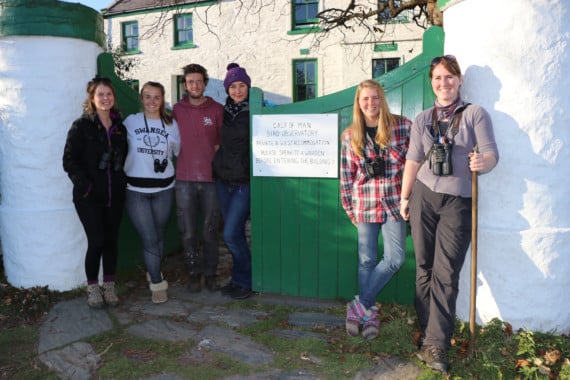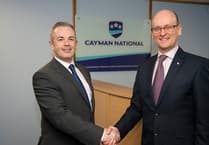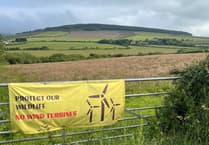Today is a great day, I’m told as I arrive at the Calf of Man Bird Observatory that’s nestled into the islet’s rolling landscape.
Libby Fox, a marine conservation intern at the Manx Wildlife Trust (MWT), explains while unpacking groceries: ’Today (Tuesday) our weekly food delivery has arrived, I can have my weekly shower and it’s washing day.’
Despite being surrounded by water, the drinkable stuff collected from rainfall is a precious commodity here and therefore restrictions are a must.
Rachel Jarvis, who’s been volunteering as a seal surveyor for two weeks, gives a tour of the observatory where all workers kick their boots off after a long day and where visitors can hire part of the cottage for overnight stays.
I’m assured that they remain in contact with the world as wi-fi exists on the island.
I bump into Alex Dodd, a bird-ringer, who was bringing in a chaffinch that had been caught in one of the many mist nets set up around the Calf.
The chaffinch had already been ringed elsewhere in the British Isles. Alex takes notes on its wing length, weight and other details to later report to the British Trust for Ornithology (BTO). She does this up to about a hundred times a day with different species to better understand migration and track populations.
It turns out that the Calf is a hotspot for migrating birds.
’We get birds from Iceland and from Norway,’ she said.
Alex is covering the work of ornithologist Aron Sapsford who was airlifted off after breaking his ankle here.
Aron had been sheltering in one of the lighthouses during Storm Ali in September when he slipped and severely injured himself.
Dan Woollard, a full-time warden, said: ’I was on the other side of the island when it happened. Fortunately Aron’s texts had got through to Lara Howe, marine officer for the MWT, in the Isle of Man but he couldn’t receive texts and the radio wasn’t going through.
’It wasn’t until an hour and a half later that I saw the text and went on my way.’
Olivia Pargeter, a bird ringer from Wales who has been covering all ornithological work on the island while Aron is away, tells me that it’s mandatory for all workers to write the location of where they will be on a whiteboard at the observatory. It was this which helped Dan to locate Aron.
’He was on the floor lying there in pain.
’I had to go back to the observatory to get signal and called Lara who had called for a helicopter to come out,’ he said.
The 60mph winds made the rescue a challenging one, but he was eventually escorted off the islet. Aron is now resting up back at his home.
Another challenge Dan faced this year was the infamous dry summer.
’We really had to minimise water use and could only have a shower over more than a week,’ he said. ’Flushing toilets was also limited.’
A few years ago, there were serious efforts to eradicate rats there as they had dramatically reduced the population of ground-nesting birds.
Dan said: ’The Manx shearwaters have come back since the eradication and there are about 400 pairs here now which is very, very good.’
Sadly it’s not the end of the rat problem.
’We had a couple of sightings this year in September on our camera traps. We put our kill traps, but haven’t had any success.’
Recently we reported that Port St Mary’s Co-op suddenly pulled the plug on helping Calf workers with their food deliveries.
’It was very frustrating,’ Libby said. ’But we now have a lady called Donna from Shoprite who helps us with the deliveries. She’s our hero.’
The food is then brought to the island by Juan Clague, his son Steven and sea dog Harley on their boat Scraayl - Manx for shearwater.
Rachel, who was heading home on Scraayl that day, said: ’You are constantly working, but I’ve really enjoyed my time here!’
She has helped Libby count and take photo identification of seal pups from 50 metres away. They have recorded 65 pups. Rachel continues to be on the lookout for a career in conservation. She believes that more Manx people like herself should visit the beautiful islet and appreciate the work done there.
The islet inhabitants are clearly grateful for the Calf of Man. Here they are given a chance to get close to nature, further their experience in a field which they say is difficult to gain a career in as well as make friends for life.
Libby, while smiling at her peers, added: ’We’re like a little dysfunctional family here.’
Do they have access to wi-fi? How do they get food? What do they actually do?
Our reporter Jess Ward visits the idyllic islet to speak to the wardens and volunteers who spend countless hours monitoring and conserving birds, seals and insects here.




-(1).jpeg?width=209&height=140&crop=209:145,smart&quality=75)
Comments
This article has no comments yet. Be the first to leave a comment.